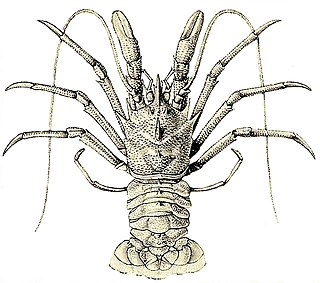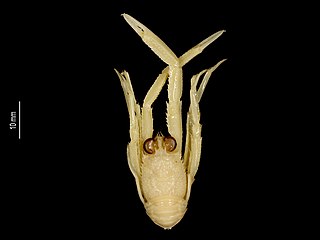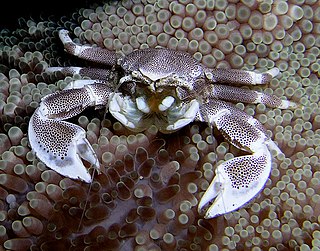Munidopsis andamanica is a species of squat lobster that lives in the deep sea and eats dead wood. It has long chelipeds, which are twice as long as the carapace.

Munidopsis serricornis is a species of squat lobster. It is widely distributed in the world's oceans, being found in the eastern Atlantic Ocean, the western Atlantic Ocean, and the Indo-Pacific. It grows up to a carapace length of 20 millimetres (0.8 in).

Munidopsis is a genus of squat lobster. It is the second largest of all the genera of squat lobsters, after Munida, with over 200 species. Its members are mainly found on continental slopes and on abyssal plains. A few fossil species are also known, including specimens from the Campanian (Cretaceous).

Chirostylus is a genus of squat lobsters in the family Chirostylidae, containing the following species:

Galacantha is a genus of squat lobsters in the family Munidopsidae, containing the following species:

Lauriea is a genus of squat lobsters in the family Galatheidae, containing the following species:

Paramunida is a genus of squat lobsters in the family Munididae, containing the following species:

Plesionida is a genus of squat lobsters in the family Munididae. As of 2017, it contains the following species:

Raymunida is a genus of squat lobsters in the family Munididae, containing the following 11 species:

The Galatheoidea are a superfamily of decapod crustaceans comprising the porcelain crabs and some squat lobsters. Squat lobsters within the three families of the superfamily Chirostyloidea are not closely related to the squat lobsters within the Galatheoidea. The fossil record of the superfamily extends back to the Middle Jurassic genus Palaeomunidopsis.
Munidopsis tuberosa is a species of squat lobster, first isolated from deep waters off Taiwan. M. tuberosa is similar to M. granosicorium, but it differs by the configuration of its carapace and rostrum.
Eumunida chani is a species of chirostylid squat lobster first found in Taiwan. This species can be distinguished by its absence of a pad of densely distributed setae on its first pereopod, the anterior branchial margin which bears two spines, and the carpus of its first pereopod carrying only two spines.
Uroptychus anatonus is a species of chirostylid squat lobster first found in Taiwan. U. anatonus and U. anacaena are similar but can be distinguished from each other by the shape of their 4th sternite and the length of their antennal scale. Both species resemble U. maori and U. brucei, but lack a ventral subterminal spine on their first pereopod's ischium.
Uroptychus singularis is a species of chirostylid squat lobster first found in Taiwan. This species is distinguished from U. australis by its single, unpaired terminal spine on its flexor margin of pereopods 2–4.
Munidopsis tafrii is a species of squat lobster first found in Taiwanese waters at depths greater than 3,000 metres (9,800 ft). It resembles M. ceratophthalma, however its carapace morphology distinguishes it from its cogenerate species.

Raymunida insulata is a species of squat lobster in the family Munididae from the Pacific and Indian oceans. The species can be distinguished by its morphology and its mitochondrial cytochrome c oxidase subunit I sequences.
Raymunida erythrina is a species of squat lobster in the family Munididae from the Pacific and Indian oceans. The species can be distinguished by its morphological characters and its mitochondrial cytochrome c oxidase subunit I sequences.

Raymunida dextralis is a species of squat lobster in the family Munididae from the Pacific and Indian oceans. The species can be distinguished by its morphological characters and its mitochondrial cytochrome c oxidase subunit I sequences.

Raymunida confundens is a species of squat lobster in the family Munididae from the Pacific and Indian oceans. The species can be distinguished by its morphological characters and its mitochondrial cytochrome c oxidase subunit I sequences.
Munidopsis taiwanica, is a species of Munidopsis, a genus of squat lobster. Named after the type locality. Deepest known record for squat lobsters at 5491m in the Mariana Trench, and is the first confirmed species of squat lobster found in the mud volcano environment.









